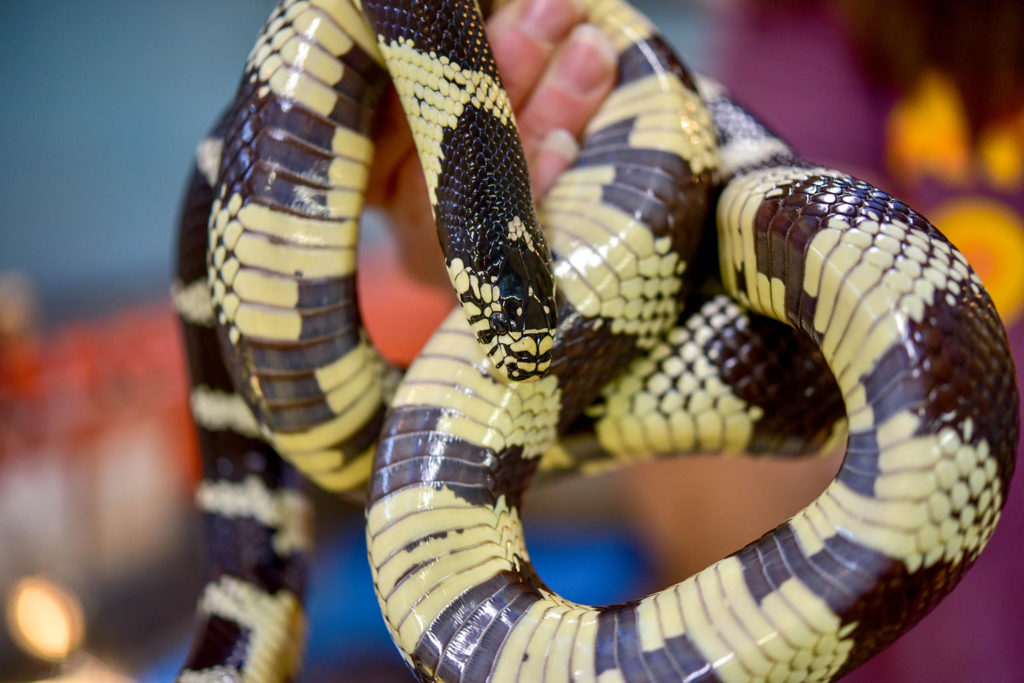Overview
“Where I live”
California kingsnakes are found throughout most of California, neighboring states, and northern Mexico. They thrive in many habitat types, from marshes and grasslands to forest, scrub, and desert.
“How I live there”
California kingsnakes do most of their hunting and cruising at dawn or dusk. During the day, they tend to rest under leaf litter or other cover or bask in the sun, depending on whether they need to stay cool or warm up. Like other reptiles, they are cold-blooded and rely on the environment to help regulate their body temperature. During the winter, these snakes burrow into crevices or under rocks, logs, or other cover and brumate.
California kingsnakes are powerful constrictors that prey upon a wide variety of animals, including other snakes, rodents and other small mammals, lizards, frogs, salamanders, birds, and large invertebrates. They also eat lizard eggs, snake eggs, and bird eggs.
California kingsnakes are active rather than ambush hunters. In other words, they go in search of their next meal rather than letting it come to them. They are largely terrestrial but can climb trees and swim.
“Making my mark”
California kingsnakes are immune to rattlesnake venom! They will prey upon rattlesnakes and other venomous snakes, given the chance. When confronted by a kingsnake, rattlesnakes do not rattle or strike. Instead, they keep their heads low, raise their bodies in a loop, and try to beat off the kingsnake when it attacks.
“What eats me”
Hawks and other raptors, skunks, and raccoons are among the known kingsnake predators. When threatened, California kingsnakes will vibrate their tails, hiss, and roll into a protective ball.
Raising Young
Several weeks after breeding, female kingsnakes lay between 3 and 24 eggs (10 on average), cover them, and then have nothing more to do with their offspring. The eggs hatch within 2 months. Baby kingsnakes stay in their nest for about 1 week, until they shed their skin for the first time, and then disperse.
Conservation
California kingsnakes are stable throughout their range. They are listed as a species of least concern by the IUCN, the world’s leading conservation organization.
Taxonomy
- Kingdom: Animalia
- Phylum: Chordata
- Subphylum: Vertebrata
- Class: Reptilia
- Genera: Lampropeltis
- Species: californiae
What is an Animal Ambassador?
The Maryland Zoo refers to its special collection of education program animals as “Animal Ambassadors.” The Zoo currently cares for more than 60 Animal Ambassadors, representing more than 40 species, both native and exotic. These animals are managed separately from the rest of the Zoo’s collection and cannot be seen on exhibit at the Zoo. However, many can be seen up close and personal on a rotating basis at Creature Encounters, the Zoo’s outdoor education center; at camp and school programs at the Zoo; as featured participants in community-based Outreach programs; and at special events on and off Zoo grounds.
Animal Ambassadors spend countless hours working with their human handlers, developing bonds of trust and communication that will allow them to appear in front of audiences large and small. They are not show animals. They behave naturally, focusing audiences’ attention on their natural behaviors and adaptations and giving living, breathing meaning to concepts and topics that students may be studying.
Animal Ambassadors travel all over the state of Maryland and beyond, and many also make local and national media appearances, educating about wildlife while representing the Zoo and its commitments to animal welfare and conservation.
What is The Animal Embassy?
The Animal Embassy at The Maryland Zoo is an off-exhibit area that is not open to the public. It is where the Zoo’s “Animal Ambassadors,” or education program animals, live. The Embassy is home to more than 60 individual animals representing more than 40 different species. It is staffed by its own dedicated group of keepers and volunteers and has both indoor and outdoor living space for the animals.

